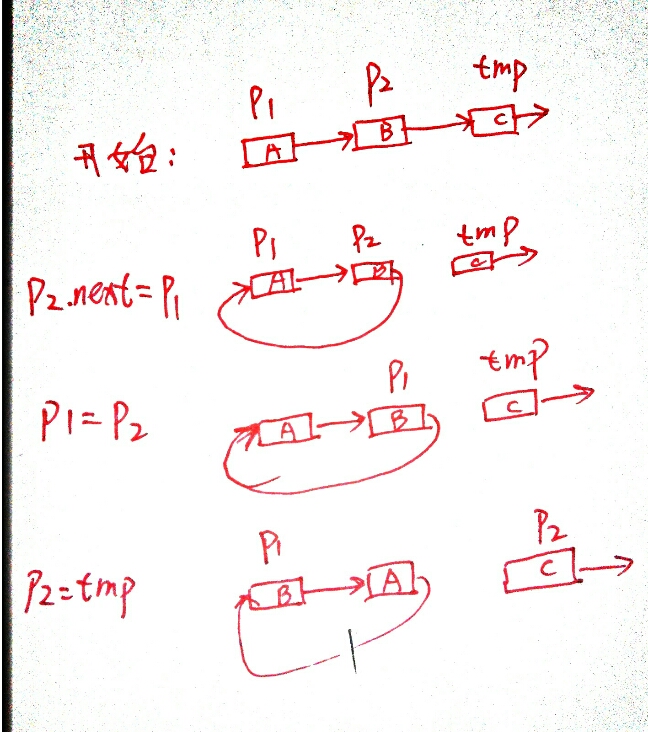题目
设计一种方式检查一个链表是否为回文链表。
样例
1->2->1 就是一个回文链表。
挑战
 Java Code
Java Code
 Python Code
Python Code
 Java Code
Java Code
 Python Code
Python Code
 Java Code
Java Code
 Java Code
Java Code
 Python Code
Python Code
O(n)的时间和O(1)的额外空间。
解题
法一:
再定义一个链表,存放链表反转的值,再以此比较两个链表中的值是否相等,时间复杂度O(N),空间复杂度O(N)

/** * Definition for singly-linked list. * public class ListNode { * int val; * ListNode next; * ListNode(int x) { val = x; } * } */ public class Solution { /** * @param head a ListNode * @return a boolean */ public boolean isPalindrome(ListNode head) { // Write your code here ArrayList<Integer> list = new ArrayList<Integer>(); if(head == null || head.next == null) return true; ListNode p = head; ListNode prev = new ListNode(head.val); while(p.next != null){ ListNode tmp = new ListNode(p.next.val); tmp.next = prev; prev = tmp; p = p.next; } ListNode p1 = head; ListNode p2 = prev; while(p1!=null){ if(p1.val != p2.val) return false; p1 = p1.next; p2 = p2.next; } return true; } }
总耗时: 2219 ms
Python下面程序出现内存溢出

# Definition for singly-linked list. # class ListNode: # def __init__(self, x): # self.val = x # self.next = None class Solution: # @param head, a ListNode # @return a boolean def isPalindrome(self, head): # Write your code here if head == None or head.next == None: return True p = head prev = ListNode(head.val) while p.next!=None: tmp = ListNode(p.next.val) tmp.next = prev prev = tmp p = p.next p1 = head p2 = prev del head del prev while p1!=None: if p1.val != p2.val: return False p1 = p1.next p2 = p2.next return True
法二:
先找到链表的中间节点,根据中间节点划分成两个链表,对第二个链表反转后在和第一个链表元素以此比较,但是下面的程序,在旋转的过程中空间复杂度好像是O(N/2) = O(N)
在找中间节点时候需要说明下
ListNode slow = head; ListNode fast = head; // 找到两个链表的中间节点 while( fast.next!=null && fast.next.next!=null){ fast = fast.next.next; slow = slow.next; }
开始时候两个节点都指向第一个节点,以后两个异步的向前走
最后结束的时候
当长度是奇数的时候:slow恰好在中间节点,fast恰好在最后一个节点。slow.next就是下一个链表的头节点。你会发现这两个链表是不一样的长的,但是在比较的时候,只要有一个链表是null的时候就结束比较的,也就是说只与第二个链表有关系的。
当长度是偶数的时候:slow在N/2的下取整处的节点,也就是中间两个节点的前一个,二fast在倒数第二个节点,下面就一样了

/** * Definition for singly-linked list. * public class ListNode { * int val; * ListNode next; * ListNode(int x) { val = x; } * } */ public class Solution { /** * @param head a ListNode * @return a boolean */ public boolean isPalindrome(ListNode head) { // Write your code here if(head == null || head.next == null) return true; ListNode slow = head; ListNode fast = head; // 找到两个链表的中间节点 while( fast.next!=null && fast.next.next!=null){ fast = fast.next.next; slow = slow.next; } ListNode secondHead = slow.next; slow.next = null; // 后半部分的节点反转 ListNode p1 = secondHead; ListNode revsecondList = new ListNode(p1.val); revsecondList.next = null; while(p1.next != null){ ListNode tmp = new ListNode(p1.next.val); tmp.next = revsecondList; revsecondList = tmp; p1 = p1.next; } // 比较两个链表 while(head!=null && revsecondList!=null){ if(head.val != revsecondList.val) return false; head = head.next; revsecondList = revsecondList.next; } return true; } }
总耗时: 2229 ms

# Definition for singly-linked list. # class ListNode: # def __init__(self, x): # self.val = x # self.next = None class Solution: # @param head, a ListNode # @return a boolean def isPalindrome(self, head): # Write your code here if head == None or head.next == None: return True slow = head fast = head while fast.next != None and fast.next.next != None: fast = fast.next.next slow = slow.next secondHead = slow.next slow.next = None p = secondHead rev = ListNode(p.val) while p.next!=None: tmp = ListNode(p.next.val) tmp.next = rev rev = tmp p = p.next while rev!=None and head!=None: if rev.val != head.val: return False rev = rev.next head = head.next return True
总耗时: 528 ms
在旋转链表的时候有重新定义了节点,如何只是修改节点而实现翻转,下面利用递归的思想翻转链表,但是在测试到97%的数据的时候运行时间超时。

public ListNode reverse(ListNode head){
if(head == null || head.next == null)
return head;
ListNode second = head.next;
head.next = null;
ListNode res = reverse(second);
second.next = head;
return res;
}
下面是定义两个指针,第一个指向头节点,第二个指向头节点后一个节点
p1 = head
p2 = p1.next
while(p1!= null && p2!= null){
ListNode tmp = p2.next;
p2.next = p1;
p1 = p2;
p2 = tmp;
}
操作如下图所示

这里可以最后A还指向B的,可以在初始定义中增加
p1 .next = null
这样每次都是在p1节点之前增加一个节点的

/** * Definition for singly-linked list. * public class ListNode { * int val; * ListNode next; * ListNode(int x) { val = x; } * } */ public class Solution { /** * @param head a ListNode * @return a boolean */ public boolean isPalindrome(ListNode head) { // Write your code here if(head == null || head.next == null) return true; ListNode slow = head; ListNode fast = head; // 找到两个链表的中间节点 while( fast.next!=null && fast.next.next!=null){ fast = fast.next.next; slow = slow.next; } ListNode secondHead = slow.next; slow.next = null; // 后半部分的节点反转 ListNode p1 = secondHead; ListNode p2 = p1.next; p1.next = null; while(p1!= null && p2!= null){ ListNode tmp = p2.next; p2.next = p1; p1 = p2; p2 = tmp; } secondHead.next = null; revsecondList = p1; // 比较两个链表 while(head!=null && revsecondList!=null){ if(head.val != revsecondList.val) return false; head = head.next; revsecondList = revsecondList.next; } return true; } }
总耗时: 2192 ms

# Definition for singly-linked list. # class ListNode: # def __init__(self, x): # self.val = x # self.next = None class Solution: # @param head, a ListNode # @return a boolean def isPalindrome(self, head): # Write your code here if head == None or head.next == None: return True fast = head slow = head while fast.next!= None and fast.next.next!=None: fast =fast.next.next slow = slow.next secondhead = slow.next slow.next = None p1 = secondhead p2 = p1.next p1.next = None while p1!=None and p2!=None: tmp = p2.next p2.next = p1 p1 = p2 p2 = tmp rev = p1 while rev!=None and head!=None: if rev.val!=head.val: return False rev = rev.next head = head.next return True
总耗时: 516 ms
